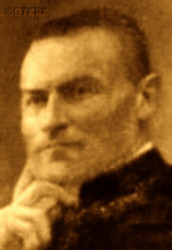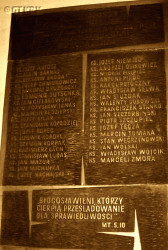Roman Catholic
St Sigismund parish
05-507 Słomczyn
85 Wiślana Str.
Konstancin deanery
Warsaw archdiocese, Poland
full list:
displayClick to display full list

searchClick to search full list by categories
wyświetlKliknij by wyświetlić pełną listę po polsku

szukajKliknij by przeszukać listę wg kategorii po polsku

Martyrology of the clergy — Poland
XX century (1914 – 1989)
personal data
surname
DUTSCHKA
forename(s)
Edmund
function
diocesan priest
creed
Latin (Roman Catholic) Church RCmore on
en.wikipedia.org
[access: 2014.09.21]
diocese / province
Przemyśl diocesemore on
www.przemyska.pl
[access: 2013.02.15]
honorary titles
Rochettum et Mantolettum canonmore on
Rochettum et Mantolettum canon
(c. 1919)
Expositorii Canonicalis canonmore on
Expositorii Canonicalis canon
(c. 1909)
date and place
of death
17.05.1941

Aktobeform.: Aktybinsk
today: Aktobe reg., Kazakhstan
more on
en.wikipedia.org
[access: 2024.03.19]
details of death
After German and Russian invasion of Poland in 09.1939 and start of the World War II, after start of Russian occupation, deported in 1940 by the Russians together with inhabitants of his village n. Lviv where resided, and hundreds of thousands Poles, to Kazakhstan where perished (got stroke and paralysis ensued).
Brzuchowice experienced a mass deportation of Poles on 13.04.1940.
After two weeks of traveling in cattle cars, the victims were thrown out at the train station in Aktyubinsk (today Aktobe).
There they were loaded onto trucks and taken to nearby villages, e.g. the village of Lokhvytskyi (today Bulaksay), c. 50 km south–west of Aktyubinsk, where everyone was forced to slave labor in collective farms.
cause of death
extermination: deportation
perpetrators
Russians
sites and events
GulagClick to display the description, KazakhstanClick to display the description, Deportations to SiberiaClick to display the description, Ribbentrop‐MolotovClick to display the description, Pius XI's encyclicalsClick to display the description
date and place
of birth
16.11.1865

Sanoktoday: Sanok urban gm., Sanok pov., Subcarpathia voiv., Poland
more on
en.wikipedia.org
[access: 2021.10.09]
presbyter (holy orders)
ordination
20.07.1890

Przemyśltoday: Przemyśl city pov., Subcarpathia voiv., Poland
more on
en.wikipedia.org
[access: 2021.04.01]
positions held
1938 – 1939
pensioner — Briukhovychitoday: Lviv urban hrom., Lviv rai., Lviv obl., Ukraine
more on
en.wikipedia.org
[access: 2021.10.09] ⋄ Blessed Virgin Mary of the Scapular RC parish ⋄ Jagiellonian Horodoktoday: Horodok, Horodok urban hrom., Lviv rai., Lviv obl., Ukraine
more on
en.wikipedia.org
[access: 2020.11.20] RC deanery
c. 1916 – c. 1935
dean — Jasłotoday: Jasło urban gm., Jasło pov., Subcarpathia voiv., Poland
more on
en.wikipedia.org
[access: 2021.10.09] RC deanery
1908 – 1938
parish priest — Szebnietoday: Jasło gm., Jasło pov., Subcarpathia voiv., Poland
more on
en.wikipedia.org
[access: 2021.10.09] ⋄ St Martin the Bishop and Confessor RC parish ⋄ Jasłotoday: Jasło urban gm., Jasło pov., Subcarpathia voiv., Poland
more on
en.wikipedia.org
[access: 2021.10.09] RC deanery
1897 – 1908
parish priest — Bachórzectoday: Dubiecko gm., Przemyśl pov., Subcarpathia voiv., Poland
more on
en.wikipedia.org
[access: 2021.10.09] ⋄ St Catherine the Virgin and Martyr RC parish ⋄ Dynówtoday: Dynów urban gm., Rzeszów pov., Subcarpathia voiv., Poland
more on
en.wikipedia.org
[access: 2021.10.09] RC deanery
c. 1896 – c. 1897
parish priest — Leskotoday: Lesko gm., Lesko pov., Subcarpathia voiv., Poland
more on
en.wikipedia.org
[access: 2021.10.09] ⋄ Visitation of the Blessed Virgin Mary RC parish ⋄ Leskotoday: Lesko gm., Lesko pov., Subcarpathia voiv., Poland
more on
en.wikipedia.org
[access: 2021.10.09] RC deanery
c. 1891
vicar — Iwonicztoday: Iwonicz Zdrój gm., Krosno pov., Subcarpathia voiv., Poland
more on
en.wikipedia.org
[access: 2021.10.09] ⋄ All the Saints RC parish ⋄ Rymanówtoday: Rymanów gm., Krosno pov., Subcarpathia voiv., Poland
more on
en.wikipedia.org
[access: 2021.10.09] RC deanery
1890 – c. 1895
vicar — Szebnietoday: Jasło gm., Jasło pov., Subcarpathia voiv., Poland
more on
en.wikipedia.org
[access: 2021.10.09] ⋄ St Martin the Bishop and Confessor RC parish ⋄ Jasłotoday: Jasło urban gm., Jasło pov., Subcarpathia voiv., Poland
more on
en.wikipedia.org
[access: 2021.10.09] RC deanery — also: during ministry served his compulsory military service in the army of the Austro–Hungarian Empire (till c. 1894)
1886 – 1890
student — Przemyśltoday: Przemyśl city pov., Subcarpathia voiv., Poland
more on
en.wikipedia.org
[access: 2021.04.01] ⋄ philosophy and theology, Theological Seminary
sites and events
descriptions
Gulag: The acronym Gulag comes from the Rus. Главное управление исправительно‐трудовых лагерей и колоний (Eng. Main Board of Correctional Labor Camps). The network of Russian concentration camps for slave labor was formally established by the decision of the highest Russian authorities on 27.06.1929. Control was taken over by the OGPU, the predecessor of the genocidal NKVD (from 1934) and the MGB (from 1946). Individual gulags (camps) were often established in remote, sparsely populated areas, where industrial or transport facilities important for the Russian state were built. They were modeled on the first „great construction of communism”, the White Sea‐Baltic Canal (1931‐1932), and Naftali Frenkel, of Jewish origin, is considered the creator of the system of using forced slave labor within the Gulag. He went down in history as the author of the principle „We have to squeeze everything out of the prisoner in the first three months — then nothing is there for us”. He was to be the creator, according to Alexander Solzhenitsyn, of the so‐called „Boiler system”, i.e. the dependence of food rations on working out a certain percentage of the norm. The term ZEK — prisoner — i.e. Rus. заключенный‐каналоармец (Eng. canal soldier) — was coined in the ITL BelBaltLag managed by him, and was adopted to mean a prisoner in Russian slave labor camps. Up to 12 mln prisoners were held in Gulag camps at one time, i.e. c. 5% of Russia's population. In his book „The Gulag Archipelago”, Solzhenitsyn estimated that c. 60 mln people were killed in the Gulag until 1956. Formally dissolved on 20.01.1960. (more on: en.wikipedia.orgClick to attempt to display webpage
[access: 2024.04.08])
Kazakhstan: In 1930‐1939 Russians exiled to Kazakhstan thousands of Poles who after Polish‐Russian war in 1920 stayed behind Polish border. In 1939‐1940, also later, Russians deported to Kazakhstan (into, among others, Aktiabińsk region) tens of thousands of Poles who slaved virtuallly on „naked” soil. (more on: www.zegocina.plClick to attempt to display webpage
[access: 2013.08.10])
Deportations to Siberia: In 1939‐1941 Russians deported — in four large groups in: 10.02.1940, 13‐14.04.1940, 05‐07.1940, 05‐06.1941 — up to 1 mln of Polish citizens from Russian occupied Poland to Siberia leaving them without any support at the place of exile. Thousands of them perished or never returned. The deportations east, deep into Russia, to Siberia resumed after 1944 when Russians took over Poland. (more on: en.wikipedia.orgClick to attempt to display webpage
[access: 2014.09.21])
Ribbentrop‐Molotov: Genocidal Russian‐German alliance pact between Russian leader Joseph Stalin and German leader Adolf Hitler signed on 23.08.1939 in Moscow by respective foreign ministers, Mr. Vyacheslav Molotov for Russia and Joachim von Ribbentrop for Germany. The pact sanctioned and was the direct cause of joint Russian and German invasion of Poland and the outbreak of the World War II in 09.1939. In a political sense, the pact was an attempt to restore the status quo ante before 1914, with one exception, namely the „commercial” exchange of the so‐called „Kingdom of Poland”, which in 1914 was part of the Russian Empire, fore Eastern Galicia (today's western Ukraine), in 1914 belonging to the Austro‐Hungarian Empire. Galicia, including Lviv, was to be taken over by the Russians, the „Kingdom of Poland” — under the name of the General Governorate — Germany. The resultant „war was one of the greatest calamities and dramas of humanity in history, for two atheistic and anti‐Christian ideologies — national and international socialism — rejected God and His fifth Decalogue commandment: Thou shall not kill!” (Abp Stanislav Gądecki, 01.09.2019). The decisions taken — backed up by the betrayal of the formal allies of Poland, France and Germany, which on 12.09.1939, at a joint conference in Abbeville, decided not to provide aid to attacked Poland and not to take military action against Germany (a clear breach of treaty obligations with Poland) — were on 28.09.1939 slightly altered and made more precise when a treaty on „German‐Russian boundaries and friendship” was agreed by the same murderous signatories. One of its findings was establishment of spheres of influence in Central and Eastern Europe and in consequence IV partition of Poland. In one of its secret annexes agreed, that: „the Signatories will not tolerate on its respective territories any Polish propaganda that affects the territory of the other Side. On their respective territories they will suppress all such propaganda and inform each other of the measures taken to accomplish it”. The agreements resulted in a series of meeting between two genocidal organization representing both sides — German Gestapo and Russian NKVD when coordination of efforts to exterminate Polish intelligentsia and Polish leading classes (in Germany called «Intelligenzaktion», in Russia took the form of Katyń massacres) where discussed. Resulted in deaths of hundreds of thousands of Polish intelligentsia, including thousands of priests presented here, and tens of millions of ordinary people,. The results of this Russian‐German pact lasted till 1989 and are still in evidence even today. (more on: en.wikipedia.orgClick to attempt to display webpage
[access: 2015.09.30])
Pius XI's encyclicals: Facing the creation of two totalitarian systems in Europe, which seemed to compete with each other, though there were more similarities than contradictions between them, Pope Pius XI issued in 03.1937 (within 5 days) two encyclicals. In the „Mit brennender Sorge” (Eng. „With Burning Concern”) published on 14.03.1938, condemned the national socialism prevailing in Germany. The Pope wrote: „Whoever, following the old Germanic‐pre‐Christian beliefs, puts various impersonal fate in the place of a personal God, denies the wisdom of God and Providence […], whoever exalts earthly values: race or nation, or state, or state system, representatives of state power or other fundamental values of human society, […] and makes them the highest standard of all values, including religious ones, and idolizes them, this one […] is far from true faith in God and from a worldview corresponding to such faith”. On 19.03.1937, published „Divini Redemptoris” (Eng. „Divine Redeemer”), in which criticized Russian communism, dialectical materialism and the class struggle theory. The Pope wrote: „Communism deprives man of freedom, and therefore the spiritual basis of all life norms. It deprives the human person of all his dignity and any moral support with which he could resist the onslaught of blind passions […] This is the new gospel that Bolshevik and godless communism preaches as a message of salvation and redemption of humanity”… Pius XI demanded that the established human law be subjected to the natural law of God , recommended the implementation of the ideal of a Christian state and society, and called on Catholics to resist. Two years later, National Socialist Germany and Communist Russia came together and started World War II. (more on: www.vatican.vaClick to attempt to display webpage
[access: 2023.05.28], www.vatican.vaClick to attempt to display webpage
[access: 2023.05.28])
sources
personal:
www.wtl.us.edu.plClick to attempt to display webpage
[access: 2013.01.17], www.podkarpacki.civitaschristiana.plClick to attempt to display webpage
[access: 2013.01.17]
bibliographical:
„Register of Latin rite Lviv metropolis clergy’s losses in 1939‐45”, Józef Krętosz, Maria Pawłowiczowa, editors, Opole, 2005
„Biographical lexicon of Lviv Roman Catholic Metropoly clergy victims of the II World War 1939‐1945”, Mary Pawłowiczowa (ed.), Fr Joseph Krętosz (ed.), Holy Cross Publishing, Opole, 2007
„Schematismus Venerabilis Cleri Dioecesis PremisliensisClick to display source page”, Przemyśl diocesa Curia, from 1866 to 1938
original images:
szebnie.archiwa.orgClick to attempt to display webpage
[access: 2014.01.28], www.miejscapamiecinarodowej.plClick to attempt to display webpage
[access: 2014.08.14]
LETTER to CUSTODIAN/ADMINISTRATOR
If you have an Email client on your communicator/computer — such as Mozilla Thunderbird, Windows Mail or Microsoft Outlook, described at WikipediaPatrz:
en.wikipedia.org, among others — try the link below, please:
LETTER to CUSTODIAN/ADMINISTRATORClick and try to call your own Email client
If however you do not run such a client or the above link is not active please send an email to the Custodian/Administrator using your account — in your customary email/correspondence engine — at the following address:

giving the following as the subject:
MARTYROLOGY: DUTSCHKA Edmund
To return to the biography press below:
 Click to return to biography
Click to return to biography









